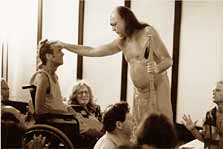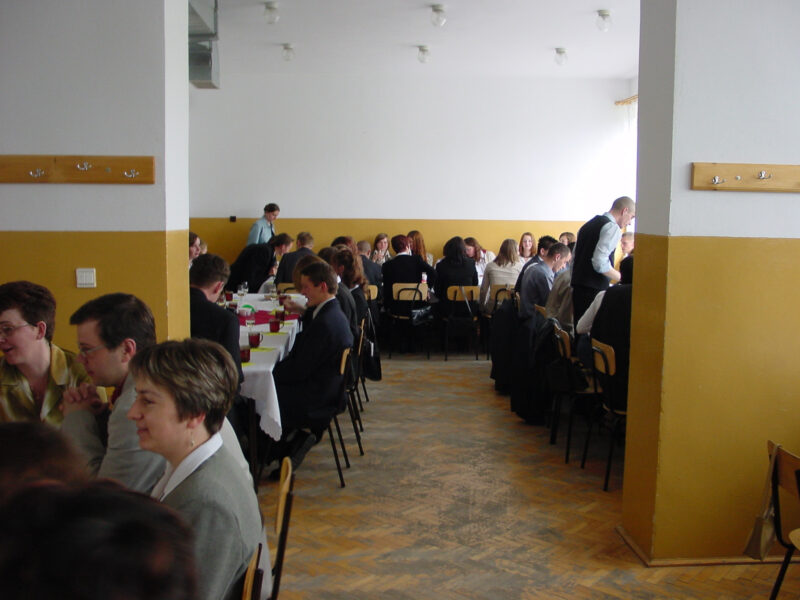After having written a short review of Dan Brown’s The Da Vinci Code (Okay, I admit it – I have to stoop to some pretty low levels in my English reading while in Poland), I recently received the oddest letter from a complete stranger. The subject line: The DaVinci [sic] Code and The DA Revelation of Avatar Adi Da Love-Ananda Samraj
Dear Gary,
My name is John Forth from Melbourne Australia. I got your e-address from Amazon reviews.
The DaVinci [sic] Code is an interesting book on an important theme: namely the suppression [sic] of the gnostic [sic] strain in Christianity. A suppresion [sic] which has turned out to be a disaster for ALL beings on this planet.
With that in mind please check out The Divine Revelation of Avatar Adi Da Love-Ananda Samraj at:
A Prophetic Criticism of the “Great” Religions (essays on how non-gnostic [sic] essentially materialist Christianity took over) at:
3. http://www.dabase.net/proofch6.htm
Grace Shines
John Forth
My response, after checking out the links he’d provided, was short: “What exactly does The Da Vinci Code – which is a horrid book filled with historical errors – have to do with a New Age cult?” Of course I knew such a reply was antagonistic enough to get another response out of him. In other words, I realized I was childishly provoking him, but I couldn’t help it. After all, it’s not every day that you get to speak to a cult apologist.
Mr. Forth replied:
Dear Gary,
Thankyou [sic] for your response.
IF you do your hope work you will discover that Adidam or The Way of the Heart created by Adi Da Samraj is not a “new age” cult. Christianity is a cult. Every body belongs to numerous cults. A cult being a group of people from the very small or in the billions fascinated by some object of desire or fascination.
Please check out “Beyond The Cultic Tendency in Religion—-” at: http://www.dabase.org/cultic.htm
You could say that the fascination with the Davinci [sic] Code is a cultish [sic] phenomenon [sic]. AS are the cults associated with The Lord of the Rings, the Matrix films, Star Trek etc etc [sic] Perhaps the relevance to Adidam is that Adi Da addresses in a very real way some of the themes, especially the repressed gnostic [sic] elements of early christianity [sic], mentioned in the Davinci [sic] Code.
Grace Shines
John Forth
Leaving aside the question of what “home work” Mr. Forth thought I was supposed to have done, I took him up on his offer and read – or rather, scanned – the piece Mr. Forth recommended, written by none other than the guru himself: Avatar Adi Da Samraj.
It was full of Things Not Normally Capitalized which were written in Capital Letters to express Their Importance (though he did restrain from some cult/sect writers’ typographical IDOCYCRIES), and basically filled with nonsensical Eastern guru babble. (I’m not suggesting that Eastern wisdom is just “babble,” just this particular “wisdom.”) Some choice quotes:
- The relationship to Me that is Described (by Me) in the Ruchira Avatara Gita is not an exoteric cultic matter. It is a profound esoteric discipline, necessarily associated with real and serious and mature practice of the “radical” Way (or root-Process) of Realizing Real God, Which Is Reality and Truth. Therefore, in the Ruchira Avatara Gita, I am critical of the ego-based (or self-saving, and self-“guruing”, rather than self-surrendering, self-forgetting, self-transcending, and Divine-Guru-Oriented) practices of childish, and, otherwise, adolescent, and, altogether, merely exoteric cultism.
- Just so, the cult of religious and Spiritual fascination tends to be equally righteous about maintaining fascinated faith (or indiscriminate, and even aggressive, belief) in the merely Parent-like “Divine” Status of one or another historical individual, “God”-Idea, religious or Spiritual doctrine, inherited tradition, or force of cosmic Nature.
The piece mainly dealt with the issue of “cultism,” which Adi Da claims is endemic in all religions – except his own, of course. His is the antidote to cults. Clever move: take critics’ charges and aim the back at them.
Next step, I decided to do my “homework” that Mr. Forth took me to task for not having done – particularly easy with Google. Soon I was flooded with information about Adi Da, Daism, and assorted goodies.
The Guru
I was initially not sure whether to call this charlatan “Franklin Jones” or “Adi Da.” Indeed, Jones himself cannot seem to make up his mind as far as names go. (names.adida.org) Continually referring to him as Jones makes his claims seem particularly absurd, but since they are currently published under the name, it seems to make contextual sense to call him “Adi Da.” In the end, I just oscillated back and forth.

I found out that – surprise, surprise – “Adi Da” is in fact Franklin Jones, a sixty-something Long Island born “guru” who has been holed up for over twenty years in Fiji , where he dispenses his Eastern-tinged “Crazy Wisdom” (his term, not mine) selflessly. I scanned a bit of his stuff and it was quickly evident that the guy is a fraud.
Jones’ religion, his “Crazy Wisdom,” is not a Siddhartha-type Western understanding of Buddhism, something which might raise the eyebrows a bit of a true Eastern master but cause no real consternation. In other words, it’s not some new meditation method, some slightly commercialized take on yoga (i.e., twelve positions for the supermarket checkout counter). Nothing so insignificant as that.
The claim that Jones make – the heart of his religion – is that he is an Avatar. A human manifestation of God. To frame it in Western terms, Jones makes the same claim Jesus did: that he is God incarnate. As he explains it:
I Am the Divine Heart-Master of every one, and of all, and of the All of all. Therefore, I Call upon every one (and all) to rightly and positively understand My Divine Self-Revelation. And I Call upon every one (and all) to truly devotionally recognize Me, and to responsively demonstrate that devotional recognition of Me in the
context of, and by Means of, the right, true, full, and fully devotional, and really counter-egoic, practice of the only-by-Me Revealed and Given Way of Adidam (www.dabase.org)
.
He is the Set Apart Guide (I can’t help lapsing into some Jones-esque capitalization) for All those Who want to Know the Way. The Way, coincidentally, is Jones himself, so his teaching amounts to how to recognize he is God. Indeed, followers are given instructions that the best way to forget about ego is to meditate on Jones, and since he’s living it up in Fiji and not physically available to all his followers, they’re provided with a photo album to help with the visualization!
Salvation, it seems, is based on fantasizing about a fat, bald, literally slimey-looking (just scroll down a bit) New Yorker with glaucoma.
The only Liberating discovery is that My Avataric Divine Spiritual Presence is Real, able to be tangibly experienced under any and all circumstances. It is not about imagining My Spiritual Presence or manipulating yourself. None of that is satisfying, in any case. To searchlessly [sic] Behold Me and, in the midst of it, to notice My Spiritual Presence tangibly moving upon you in your real experience–this is the great and Liberating discovery, the only Satisfaction. Ultimately, it is the only Satisfaction in life. Everything else is temporary, conditional, ego-based, and disheartening. Only the discovery of the tangible Reality of That Which Is Divine is heartening and Liberating and Satisfactory (adidam.org).
The practice is searchless, ego-forgetting, altogether to-Me-turned Beholding of Me in My bodily (human) Divine Form. When you are not in My physical Company, you can recollect My bodily (human) Divine Form. You can use My Murti-Form, My Padukas, and so on. Persisting in this practice, there is the potential of moving Me to Bless you further. [March 24, 2003] (adidam.org)


I closed my eyes and pictured him for a few moments and the only result I got was a chill running down my back and a brief
paranoia that, like the catchy melody of the latest pop trash hit, the image would keep popping back into my head unwanted.The Suckers and VictimsThe case of Franklin Jones and his AdidDaSes (the name “Adi Da” supposed just came to him; perhaps he just glanced down at someone’s athletic shoes) would be more comic than anything if it weren’t for the people that follow him. The difference between a cult leader and a raving schizophrenic homeless man in a subway station is that someone has taken the former seriously, and that’s a frightening thought. What makes a cult tragic is of course the devoted, mindless followers.Jones’ website speaks of “turning to him,” of “recognizing him,” of “loving him.” It’s scary stuff. But the words are not half as scary as the pictures – images from the inside workings of a cultic compound. Imagine David Koresh made pictures available of what went on in Waco. It might look something like this:And what’s worse is the fact that there are children being raised on this bullshit. Children of followers living on Jones’ Fiji island paradise are taught from birth (i.e., primarily socialization) that this snake-oil salesman is God. It’s difficult enough to deprogram adults who have surrendered (voluntarily or not) their grip on reality, but these poor kids will never have had a firm understanding of reality to begin with, and they’re going to be warped for life. It’s nothing short of child abuse, but unfortunately, such child abuse is legal.Thus armed, I dashed off a quick reply to Mr. Forth:
I read the piece to which you sent me the link, and I found this passage:
All cults, whether sacred or secular, thrive on indulgence in the psychology (and the emotional rituals) of hope, rather than on actual demonstration of counter-egoic and really ego-transcending action.
What is the difference between this “indulgence in the psychology [. . .] of hope” and what Adi Da offers? His form of TM simply offers the hope of getting in touch with true reality.
I suppose, to some degree, as an atheist I would agree. Any time we seek from a religion something beyond what we experience in our senses, quantitatively confirmable through science, we are indulging in “the psychology [. . .] of hope.”
Further, I would go so far as to say that Da is exploiting this “psychology [. . .] of hope” to build up his own cult. And for the record, I am using “cult” in the sociological sense of the term. Like Jim Jones (though I don’t know that Da will go so far), he has holed himself up in a remote corner of the world and refuses contact with outsiders.
Concerning this, Ken Wilber asks,
[Da’s] claim, of course, is that he is the most enlightened person in the history of the planet. Just for argument, let us agree. But then what would the most enlightened World Teacher in history actually do in the world? Hide? Avoid? Run? Or would that teacher engage the world, step into the arena of dialogue, meet with other religious teachers and adepts, attempt to start a universal dialogue that would test his truths in the fire of the circle of those who could usefully challenge him. At the very least, a person who claims to be the World Teacher needs to get out in the world, no? (www.beezone.com)
Indeed, what does the Dali Lama think of Da? How is he received in, say, India? Yes, yes, I know that some notables (most disturbing, Allan Watts) have given credence to Da’s claim, but as far as I know, true spiritual leaders don’t have much to do with him.
 |  |
| When I wrote this, I was still unaware of the extent of Jones’ claims to be God. As such, it’s a little flawed, for there does indeed exist a Gnostic element in Daism – the knowledge that a fat New Yorker is God. |
Now, as far as this and some connection to that horrid The Da Vinci Code, I still fail to see the connection. Gnosticism was not about mystical meditation but instead knowledge. “Gnosis” means “knowledge,” not meditation. The Da Vinci Code attempts to rehabilitate the idea of the sacred feminine – goddess worship, in other words – and not Christian mysticism. If that’s what Brown were trying to do in writing “DC” he would have written about, say, Father Pio. Instead, he wrote about Mary Magdalene, the “proper” object of veneration in Christianity as it was originally formulated.
In closing, I’d like to thank you for your emails, and encourage you, if you are involved in Adi Da’s cult, to get yourself out as fast as possible.
I never heard from Mr. Forth again. I suppose he realized that time trying to convert me was not time well spent, and I imagine he’s off emailing other people who submitted reviews of The Da Vinci Code to Amazon.com.The Ultimate Sell: YourselfOne question remains: to what degree does Franklin Jones believe his own nonsense? There are two equally disturbing possibilities. The first is that he simply knows that he’s a charlatan and realizes it’s all a big scam. This seems unlikely, for a conscious con-man, no matter how good he is, eventually slips up.The second possibility is that he thinks he is God. This simply means he belongs in an asylum. Indeed, the only difference between Franklin Jones and the probably uncountable number of Jesuses, Buddhas, Thors, and Jehovahs sitting around in state hospitals is that Jones hasn’t been locked away. You can almost imagine a large nurse reassuring a pajama-clad Jones, “Yes, Mr. Jones, I know that my salvation rests on perfect contemplation of you. Now be a sweetie and take your medicine . . .”












 Vodka accounts for many of the little surprises I’ve noticed around here — missing fingers, for instance. Many men in Lipnica have part or all of one or more fingers missing. I knew fairly early on that this would be a result of carelessness in one of the many sawmills in the village, but I thought, “Come on, simple carelessness doesn’t account for it.” Then I saw a man covered with wood chips and sawdust come into a shop and buy a half-liter of vodka.
Vodka accounts for many of the little surprises I’ve noticed around here — missing fingers, for instance. Many men in Lipnica have part or all of one or more fingers missing. I knew fairly early on that this would be a result of carelessness in one of the many sawmills in the village, but I thought, “Come on, simple carelessness doesn’t account for it.” Then I saw a man covered with wood chips and sawdust come into a shop and buy a half-liter of vodka. As far as straight drinking goes, though, Poles, while they out-drink Americans to a lip-numbing degree, are teetotalers in comparison to Russians. I once saw a documentery in Poland, called Z?ota Ryba (“The Golden Fish”), about vodka in Russia. It showed a home distillary that produced 140 proof (i.e., 70% alcohol) vodka that even Grandma was tossing back by the full glass (Not a shot glass, mind you, but the size Poles use for coffee and tea.), without a chaser.
As far as straight drinking goes, though, Poles, while they out-drink Americans to a lip-numbing degree, are teetotalers in comparison to Russians. I once saw a documentery in Poland, called Z?ota Ryba (“The Golden Fish”), about vodka in Russia. It showed a home distillary that produced 140 proof (i.e., 70% alcohol) vodka that even Grandma was tossing back by the full glass (Not a shot glass, mind you, but the size Poles use for coffee and tea.), without a chaser.
 I’ll never forget the first time I saw it: standing in a shop at seven in the morning, waiting to buy something for breakfast, I watch a man come in, buy a beer, down it in one long gulp (for lack of a better word), put the bottle on the counter and walk out. Seven in the morning.
I’ll never forget the first time I saw it: standing in a shop at seven in the morning, waiting to buy something for breakfast, I watch a man come in, buy a beer, down it in one long gulp (for lack of a better word), put the bottle on the counter and walk out. Seven in the morning.

































